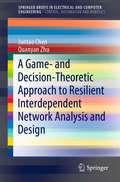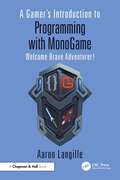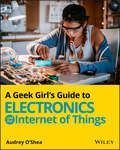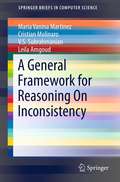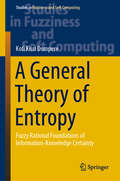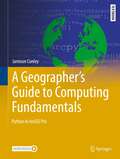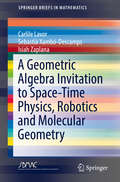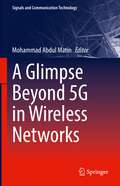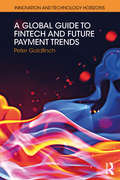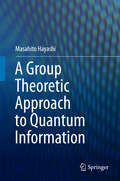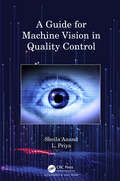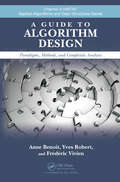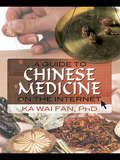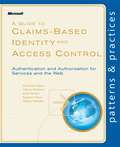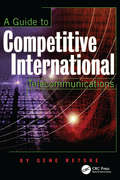- Table View
- List View
A Game- and Decision-Theoretic Approach to Resilient Interdependent Network Analysis and Design (SpringerBriefs in Electrical and Computer Engineering)
by Quanyan Zhu Juntao ChenThis brief introduces game- and decision-theoretical techniques for the analysis and design of resilient interdependent networks. It unites game and decision theory with network science to lay a system-theoretical foundation for understanding the resiliency of interdependent and heterogeneous network systems. The authors pay particular attention to critical infrastructure systems, such as electric power, water, transportation, and communications. They discuss how infrastructure networks are becoming increasingly interconnected as the integration of Internet of Things devices, and how a single-point failure in one network can propagate to other infrastructures, creating an enormous social and economic impact. The specific topics in the book include: · static and dynamic meta-network resilience game analysis and design; · optimal control of interdependent epidemics spreading over complex networks; and · applications to secure and resilient design of critical infrastructures. These topics are supported by up-to-date summaries of the authors’ recent research findings. The authors then discuss the future challenges and directions in the analysis and design of interdependent networks and explain the role of multi-disciplinary research has in computer science, engineering, public policy, and social sciences fields of study. The brief introduces new application areas in mathematics, economics, and system and control theory, and will be of interest to researchers and practitioners looking for new approaches to assess and mitigate risks in their systems and enhance their network resilience. A Game- and Decision-Theoretic Approach to Resilient Interdependent Network Analysis and Design also has self-contained chapters, which allows for multiple levels of reading by anyone with an interest in game and decision theory and network science.
A Gamer's Introduction to Programming in C#: Welcome Brave Adventurer!
by Aaron LangilleTurn your love of video games into a new love of programming by learning the ins and outs of writing code while also learning how to keep track of high scores, what video game heroes and loot boxes are made of, how the dreaded RNG (random number generation) works, and much, much more. This book is the first in an ongoing series designed to take readers from no coding knowledge to writing their own video games and interactive digital experiences using industry standard languages and tools. But coding books are technical, boring, and scary, aren’t they? Not this one. Within these pages, readers will find a fun and approachable adventure that will introduce them to the essential programming fundamentals like variables, computer-based math operations, RNG, logic structures, including if-statements and loops, and even some object-oriented programming. Using Visual Studio and C#, readers will write simple but fun console programs and text-based games that will build coding skills and confidence. Packed with practical examples and plain-language explanations, this book is structured like a video game, complete with levels to progress through, bonus levels for extra practice, cutscenes that offer info-packed coding breaks, and end-of-level code rewards to illustrate how everything fits together. Gain even more experience by exploring the resources and bonus materials at the companion website: https://welcomebraveadventurer.ca. Engaging and concise, this book is appealing to both a general readership as well as course convenors and students of programming. Put on your cap of +5 courage and level up by joining the coding adventure that awaits you inside!
A Gamer's Introduction to Programming with MonoGame: Welcome Brave Adventurer!
by Aaron LangilleA Gamer’s Introduction to Programming with MonoGame: Welcome Brave Adventurer! is a great way to combine your current love of both video games and coding into a brand‑new love of writing your own games. In this book, you’ll learn the essential ins‑and‑outs of how to work with fonts and text, images and sprites, audio, and even animation. You’ll learn how to give your players control over their destiny through keyboards, mice, and gamepads, and you’ll harness the never‑ending energy of the gameplay loop functions. But coding books are technical, boring, and scary, aren’t they? Not this one. Within these pages, you’ll find a fun and approachable adventure that will introduce you to the accessible but powerful MonoGame development framework. Using Visual Studio and C#, you’ll write simple but engaging interactive scenes and games that will gradually build up your coding skills and confidence. Packed with practical examples, plain‑language explanations, images, and illustrations, this book is structured like a video game, complete with levels to progress through, cutscenes to give you extra information, and final challenge projects to show you how everything fits together and to help build your own creative portfolio. It is also the second book in an ongoing series designed to take you from zero experience to writing your own video games and interactive digital experiences using industry standard languages and tools. For readers with previous object‑oriented programming experience, this book is a standalone introductory MonoGame adventure. Gain even more experience by exploring the resources, bonus materials, and extensive code samples available at the companion website: https://welcomebraveadventurer.ca. Now, gather your courage and prepare to level up by joining the MonoGame coding quests that await you inside.
A Geek Girl's Guide to Electronics and the Internet of Things
by Audrey O'SheaA straightforward demystification of electronics and the Internet of Things A Geek Girl's Guide to Electronics and the Internet of Things breaks down and simplifies electronics and the Internet of Things for the layperson. Written by a leading technical school instructor with a talent for bringing complex topics to everyday people, this book provides concrete examples and practical advice for anyone interested in building, repairing, or studying electronics and functional Internet of Things (IoT) devices. A Geek Girl’s Guide to Electronics and the Internet of Things explores a wide range of topics including, among others: Ohm’s and Watt's Law Series and Parallel Circuits Diodes, transistors, capacitors and relays Motors and Pulse with Modulation Using light to control electricity Photovoltaic Cells and Transducers Enhancing circuits with Arduino Connecting circuits to networks The distinguished author’s website includes videos to help you build and enhance projects, along with deeper information to enrich your learning. Additionally, the book goes beyond theory and teaches readers how circuit components become IoT devices and provide the data that drive our modern world. The combination of hands-on activities and solid pedagogy ensures long-lasting retention of the material for everyone.
A General Framework for Reasoning On Inconsistency (SpringerBriefs in Computer Science)
by V. S. Subrahmanian Maria Vanina Martinez Leila Amgoud Cristian MolinaroThis SpringerBrief proposes a general framework for reasoning about inconsistency in a wide variety of logics, including inconsistency resolution methods that have not yet been studied. The proposed framework allows users to specify preferences on how to resolve inconsistency when there are multiple ways to do so. This empowers users to resolve inconsistency in data leveraging both their detailed knowledge of the data as well as their application needs. The brief shows that the framework is well-suited to handle inconsistency in several logics, and provides algorithms to compute preferred options. Finally, the brief shows that the framework not only captures several existing works, but also supports reasoning about inconsistency in several logics for which no such methods exist today.
A General Theory of Entropy: Fuzzy Rational Foundations of Information-Knowledge Certainty (Studies in Fuzziness and Soft Computing #384)
by Kofi Kissi DompereThis book presents an epistemic framework for dealing with information-knowledge and certainty-uncertainty problems within the space of quality-quantity dualities. It bridges between theoretical concepts of entropy and entropy measurements, proposing the concept and measurement of fuzzy-stochastic entropy that is applicable to all areas of knowing under human cognitive limitations over the epistemological space. The book builds on two previous monographs by the same author concerning theories of info-statics and info-dynamics, to deal with identification and transformation problems respectively. The theoretical framework is developed by using the toolboxes such as those of the principle of opposites, systems of actual-potential polarities and negative-positive dualities, under different cost-benefit time-structures. The category theory and the fuzzy paradigm of thought, under methodological constructionism-reductionism duality, are used in the fuzzy-stochastic and cost-benefit spaces to point to directions of global application in knowing, knowledge and decision-choice actions. Thus, the book is concerned with a general theory of entropy, showing how the fuzzy paradigm of thought is developed to deal with the problems of qualitative-quantitative uncertainties over the fuzzy-stochastic space, which will be applicable to conditions of soft-hard data, fact, evidence and knowledge over the spaces of problem-solution dualities, decision-choice actions in sciences, non-sciences, engineering and planning sciences to abstract acceptable information-knowledge elements.
A Gentle Introduction to Data, Learning, and Model Order Reduction: Techniques and Twinning Methodologies (Studies in Big Data #174)
by Francisco Chinesta Elías Cueto David González Icíar Alfaro Amine Ammar Victor Champaney Chady Ghnatios Nicolas Hascoët Daniele Di Lorenzo Angelo Pasquale Dominique BaillargeatThis open access book explores the latest advancements in simulation performance, driven by model order reduction, informed and augmented machine learning technologies and their combination into the so-called hybrid digital twins. It provides a comprehensive review of three key frameworks shaping modern engineering simulations: physics-based models, data-driven approaches, and hybrid techniques that integrate both. The book examines the limitations of traditional models, the role of data acquisition in uncovering underlying patterns, and how physics-informed and augmented learning techniques contribute to the development of digital twins. Organized into four sections—Around Data, Around Learning, Around Reduction, and Around Data Assimilation & Twinning—this book offers an essential resource for researchers, engineers, and students seeking to understand and apply cutting-edge simulation methodologies
A Gentle Introduction to Optimization
by B. Guenin J. Könemann L. TunçelOptimization is an essential technique for solving problems in areas as diverse as accounting, computer science and engineering. Assuming only basic linear algebra and with a clear focus on the fundamental concepts, this textbook is the perfect starting point for first- and second-year undergraduate students from a wide range of backgrounds and with varying levels of ability. Modern, real-world examples motivate the theory throughout. The authors keep the text as concise and focused as possible, with more advanced material treated separately or in starred exercises. Chapters are self-contained so that instructors and students can adapt the material to suit their own needs and a wide selection of over 140 exercises gives readers the opportunity to try out the skills they gain in each section. Solutions are available for instructors. The book also provides suggestions for further reading to help students take the next step to more advanced material.
A Gentle Introduction to Scientific Computing (Chapman & Hall/CRC Numerical Analysis and Scientific Computing Series)
by Dan Stanescu Long LeeScientific Computation has established itself as a stand-alone area of knowledge in the border area between computer science and applied mathematics. Nonetheless, its interdisciplinary character cannot be denied: its methodologies are increasingly used in a wide variety of branches of science and engineering. A Gentle Introduction to Scientific Computing intends to serve a very broad audience of college students across a variety of disciplines. It aims to expose its readers to some of the basic tools and techniques used in computational science, with a view to helping them understand what happens ‘behind the scenes’ when simple tools such as solving equations, plotting and interpolation are used. To make the book as practical as possible, the authors explore their subject both from a theoretical, mathematical perspective and from an implementation-driven, programming perspective. Features Takes a middle ground approach between theoretical book and implementation Suitable reading for a broad range of students in STEM disciplines, and could be the primary text for a first course in scientific computing Introduces mathematics majors, without any prior computer science exposure, to numerical methods All mathematical knowledge needed beyond Calculus (and the more useful Calculus notation and concepts) is introduced in the text to make it self-contained.
A Geographer's Guide to Computing Fundamentals: Python in ArcGIS Pro (Springer Textbooks in Earth Sciences, Geography and Environment)
by Jamison ConleyThis upper-undergraduate textbook teaches students programming in GIS using a mix of computer science theory and hands-on activities, with the aim of empowering students to understand fundamentals and apply their knowledge beyond the specific examples in the book. Each of the book’s twenty-one chapters integrates instructional material with exercises in ArcGIS Pro. In doing so, this book combines the strengths of workbooks and theoretical textbooks to provide a holistic and comprehensive text. Each chapter concludes with an unguided task that ensures students have learned the broader principles explained therein. In addition to its unique format, the book covers oft-neglected topics such as debugging, creating a program from scratch, and managing metadata. Section I starts with the principles of scripting and programming with Python. Section II introduces the ArcPy module and elements specific to ArcGIS Pro. This section focuses on data structures, and how they are used and implemented within Python. Section III uses the topic of algorithms to guide the student through creating tools to add functionality to ArcGIS Pro. The last section, Section IV, builds upon section III to guide the student to developing and sharing projects and Python packages to include external open-source code and share the Python code as an open-source package. This text will prepare students for a long-term ability to do GIS programming, whether in industry or academic research. This comes from the author’s observations of students who have learned GIS programming in one platform, such as VBA in ArcMap, struggle to apply that knowledge to a new platform, such as Python in ArcGIS Pro, because the content was presented too closely with a specific platform. The integration of exercises with conceptual content, along with the choice of chapter content, serves this goal of preparing students for working in a dynamic, rapidly changing technology field.
A Geometric Algebra Invitation to Space-Time Physics, Robotics and Molecular Geometry (SpringerBriefs in Mathematics)
by Carlile Lavor Sebastià Xambó-Descamps Isiah ZaplanaThis book offers a gentle introduction to key elements of Geometric Algebra, along with their applications in Physics, Robotics and Molecular Geometry. Major applications covered are the physics of space-time, including Maxwell electromagnetism and the Dirac equation; robotics, including formulations for the forward and inverse kinematics and an overview of the singularity problem for serial robots; and molecular geometry, with 3D-protein structure calculations using NMR data. The book is primarily intended for graduate students and advanced undergraduates in related fields, but can also benefit professionals in search of a pedagogical presentation of these subjects.
A Geometric Approach to the Unification of Symbolic Structures and Neural Networks (Studies in Computational Intelligence #910)
by Tiansi DongThe unification of symbolist and connectionist models is a major trend in AI. The key is to keep the symbolic semantics unchanged. Unfortunately, present embedding approaches cannot. The approach in this book makes the unification possible. It is indeed a new and promising approach in AI. -Bo Zhang, Director of AI Institute, TsinghuaIt is indeed wonderful to see the reviving of the important theme Nural Symbolic Model. Given the popularity and prevalence of deep learning, symbolic processing is often neglected or downplayed. This book confronts this old issue head on, with a historical look, incorporating recent advances and new perspectives, thus leading to promising new methods and approaches. -Ron Sun (RPI), on Governing Board of Cognitive Science SocietyBoth for language and humor, approaches like those described in this book are the way to snickerdoodle wombats. -Christian F. Hempelmann (Texas A&M-Commerce) on Executive Board of International Society for Humor Studies
A Gift of Fire: Social, Legal, and Ethical Issues for Computing Technology
by Sara Baase Timothy M. HenryFor courses in Computer Ethics and Computers and Society. An objective study of technology ethics that inspires critical thinking and debate, <p><p> In Gift of Fire, A: Social, Legal, and Ethical Issues for Computing Technology, Sara Baase presents a balanced exploration of the social, legal, philosophical, ethical, political, constitutional, and economic implications of computing and the controversies they raise. With an objective computer scientist's perspective, and with historical context for many issues, Baase covers the issues readers will face both as members of a technological society and as professionals in computer-related fields. A primary goal is to develop computer professionals who understand the implications of what they create and how it fits into society at large. This text encourages readers to think about the ethics and philosophical direction behind topics but doesn't lead students to conclusions. <p><p>The 5th Edition contains updated material on new topics and examples, outdated material has been removed, and several topics have been reorganized. New material appears throughout, including material on current trending topics such as drones and autonomous cars.
A Girl's Life Online
by Katherine TarboxKatherine Tarbox was thirteen when she met twenty-three-year-old "Mark" in an online chat room. A top student and nationally ranked swimmer attending an elite school in an affluent Connecticut town, Katie was also a lonely and self-conscious eighth-grader who craved the attention her workaholic parents couldn't give her. "Mark" seemed to understand her; he told her she was smart and wonderful. When they set a date to finally meet while Katie was in Texas for a swim competition, she walked into a hotel room and discovered who-and what-her cyber soul mate really was. In A Girl's Life Online, Tarbox, now eighteen, tells her story-an eye-opening tale of one teenager's descent into the seductive world of the Internet. Tarbox's harrowing experience with her online boyfriend would affect her life for years to come and result in her becoming the first "unnamed minor" to test a federal law enacted to protect kids from online sexual predators. In an age when a new generation is growing up online, Tarbox's memoir is a cautionary tale for the Internet Age.
A Glimpse Beyond 5G in Wireless Networks (Signals and Communication Technology)
by Mohammad Abdul MatinThis book gathers the latest research findings on emerging trends in 5G and beyond wireless systems. The authors present and assess different enabling technologies, capabilities, and anticipated communications and computing solutions for 5G and beyond. Topics discussed include new frequency bands, new multiple antenna systems, massive D2D connectivity, new network deployment, and more. These discussions help the readers to understand more advanced research materials for developing new ideas to make a contribution in this field for themselves. This book aims to serve as a virtual and effective bridge between academic research in theory and engineering development in practice. Students, professional, and practitioners who seek to learn the latest development in wireless technologies should find interest in this book.
A Global Guide to FinTech and Future Payment Trends (Innovation and Technology Horizons)
by Peter GoldfinchBeing able to make and receive payments is an essential facet of modern life. It is integral to the banking and finance systems, and it touches all global citizens. In some areas, payment systems are rapidly evolving – moving swiftly from paper payment instruments, to electronic, to real-time – but in others, underdeveloped payment systems hold back economic and social development. This book is intended to assist the reader in navigating the payments landscape. The author explores highly topical areas, such as the role of payment systems in enabling commerce to contribute to the development of emerging economies, the evolution of payment systems from paper instruments to computerization, the role of cryptocurrencies, and the slow decline of plastic credit and debit cards owing to alternative forms of payment being introduced. Altogether, this book provides a comprehensive overview of the evolution of payment and offers projections for the future, encouraging readers to explore their own predictions, using the framework that the book has provided. It is vital reading for technologists, marketers, executives and investors in the FinTech sector, as well as academics teaching business and technology courses.
A Group Theoretic Approach to Quantum Information
by Masahito HayashiThis book is the first one addressing quantum information from the viewpoint of group symmetry. Quantum systems have a group symmetrical structure. This structure enables to handle systematically quantum information processing. However, there is no other textbook focusing on group symmetry for quantum information although there exist many textbooks for group representation. After the mathematical preparation of quantum information, this book discusses quantum entanglement and its quantification by using group symmetry. Group symmetry drastically simplifies the calculation of several entanglement measures although their calculations are usually very difficult to handle. This book treats optimal information processes including quantum state estimation, quantum state cloning, estimation of group action and quantum channel etc. Usually it is very difficult to derive the optimal quantum information processes without asymptotic setting of these topics. However, group symmetry allows to derive these optimal solutions without assuming the asymptotic setting. Next, this book addresses the quantum error correcting code with the symmetric structure of Weyl-Heisenberg groups. This structure leads to understand the quantum error correcting code systematically. Finally, this book focuses on the quantum universal information protocols by using the group SU(d). This topic can be regarded as a quantum version of the Csiszar-Korner's universal coding theory with the type method. The required mathematical knowledge about group representation is summarized in the companion book, Group Representation for Quantum Theory.
A Guide for Machine Vision in Quality Control
by Sheila Anand L. PriyaMachine Vision systems combine image processing with industrial automation. One of the primary areas of application of Machine Vision in the Industry is in the area of Quality Control. Machine vision provides fast, economic and reliable inspection that improves quality as well as business productivity. Building machine vision applications is a challenging task as each application is unique, with its own requirements and desired outcome. A Guide to Machine Vision in Quality Control follows a practitioner’s approach to learning machine vision. The book provides guidance on how to build machine vision systems for quality inspections. Practical applications from the Industry have been discussed to provide a good understanding of usage of machine vision for quality control. Real-world case studies have been used to explain the process of building machine vision solutions. The book offers comprehensive coverage of the essential topics, that includes: Introduction to Machine Vision Fundamentals of Digital Images Discussion of various machine vision system components Digital image processing related to quality control Overview of automation The book can be used by students and academics, as well as by industry professionals, to understand the fundamentals of machine vision. Updates to the on-going technological innovations have been provided with a discussion on emerging trends in machine vision and smart factories of the future. Sheila Anand is a PhD graduate and Professor at Rajalakshmi Engineering College, Chennai, India. She has over three decades of experience in teaching, consultancy and research. She has worked in the software industry and has extensive experience in development of software applications and in systems audit of financial, manufacturing and trading organizations. She guides Ph.D. aspirants and many of her research scholars have since been awarded their doctoral degree. She has published many papers in national and international journals and is a reviewer for several journals of repute. L Priya is a PhD graduate working as Associate Professor and Head, Department of Information Technology at Rajalakshmi Engineering College, Chennai, India. She has nearly two decades of teaching experience and good exposure to consultancy and research. She has delivered many invited talks, presented papers and won several paper awards in International Conferences. She has published several papers in International journals and is a reviewer for SCI indexed journals. Her areas of interest include Machine Vision, Wireless Communication and Machine Learning.
A Guide to Algorithm Design: Paradigms, Methods, and Complexity Analysis (Chapman & Hall/CRC Applied Algorithms and Data Structures series)
by Yves Robert Anne Benoit Frédéric VivienPresenting a complementary perspective to standard books on algorithms, A Guide to Algorithm Design: Paradigms, Methods, and Complexity Analysis provides a roadmap for readers to determine the difficulty of an algorithmic problem by finding an optimal solution or proving complexity results. It gives a practical treatment of algorithmic complexity and guides readers in solving algorithmic problems.Divided into three parts, the book offers a comprehensive set of problems with solutions as well as in-depth case studies that demonstrate how to assess the complexity of a new problem. Part I helps readers understand the main design principles and design efficient algorithms. Part II covers polynomial reductions from NP-complete problems and approaches that go beyond NP-completeness. Part III supplies readers with tools and techniques to evaluate problem complexity, including how to determine which instances are polynomial and which are NP-hard. Drawing on the authors’ classroom-tested material, this text takes readers step by step through the concepts and methods for analyzing algorithmic complexity. Through many problems and detailed examples, readers can investigate polynomial-time algorithms and NP-completeness and beyond.
A Guide to Authentic e-Learning (Connecting with E-learning)
by Thomas C. Reeves Jan Herrington Ron OliverPart of the groundbreaking Connecting with e-Learning series, A Guide to Authentic e-Learning provides effective, working examples to engage learners with authentic tasks in online settings. As technology continues to open up possibilities for innovative and effective teaching and learning opportunities, students and teachers are no longer content to accept familiar classroom or lecture-based pedagogies that rely on information delivery and little else. Situated and constructivist theories advocate that learning is best achieved in circumstances resembling the real-life application of knowledge. While there are multiple learning design models that share similar foundations, authentic e-learning tasks go beyond process to become complex, sustained activities that draw on realistic situations to produce realistic outcomes. A Guide to Authentic e-Learning: develops the conceptual framework for authentic learning tasks in online environments provides practical guidance on design, implementation, and evaluation of authentic e-learning tasks includes case studies and examples of outcomes of using authentic e-learning tasks Written for teaching professionals in Higher Education who teach online, A Guide to Authentic e-Learning offers concrete guidelines and examples for developing and implementing authentic e-learning tasks in ways that challenge students to maximize their learning. This essential book provides effective, working examples to engages learners with authentic tasks in online learning settings.
A Guide to Chinese Medicine on the Internet
by Ka Wai FanA Guide to Chinese Medicine on the Internet frees readers from having to sift through countless websites to find up-to-date, high quality, reliable information on all types of Chinese medicine. This handy resource provides an introduction to the terms and philosophies of Chinese medicine in addition to an extensive categorized listing of online sites related to Chinese culture and medicine, complete with a brief description of each site’s content. Guidelines are provided for searching, cataloging, and evaluating websites concerned with Chinese medicine, based on the author’s research and personal experience as a practitioner and user of Chinese medicines.
A Guide to Claims-Based Identity and Access Control
by Dominick Baier Vittorio Bertocci Keith Brown Matias Woloski Eugenio PaceAs systems have become interconnected and more complicated, programmers needed ways to identify parties across multiple computers. One way to do this was for the parties that used applications on one computer to authenticate to the applications (and/or operating systems) that ran on the other computers. This mechanism is still widely used-for example, when logging on to a great number of Web sites. However, this approach becomes unmanageable when you have many co-operating systems (as is the case, for example, in the enterprise). Therefore, specialized services were invented that would register and authenticate users, and subsequently provide claims about them to interested applications. Some well-known examples are NTLM, Kerberos, Public Key Infrastructure (PKI), and the Security Assertion Markup Language (SAML). Most enterprise applications need some basic user security features. At a minimum, they need to authenticate their users, and many also need to authorize access to certain features so that only privileged users can get to them. Some apps must go further and audit what the user does. On Windows®, these features are built into the operating system and are usually quite easy to integrate into an application. By taking advantage of Windows integrated authentication, you don't have to invent your own authentication protocol or manage a user database. By using access control lists (ACLs), impersonation, and features such as groups, you can implement authorization with very little code. Indeed, this advice applies no matter which OS you are using. It's almost always a better idea to integrate closely with the security features in your OS rather than reinventing those features yourself. But what happens when you want to extend reach to users who don't happen to have Windows accounts? What about users who aren't running Windows at all? More and more applications need this type of reach, which seems to fly in the face of traditional advice. This book gives you enough information to evaluate claims-based identity as a possible option when you're planning a new application or making changes to an existing one. It is intended for any architect, developer, or information technology (IT) professional who designs, builds, or operates Web applications and services that require identity information about their users.
A Guide to Competitive International Telecommunications
by Gene RetskeThis book provides vital information on the business, technical, legal and practical considerations in the 'New Telecom World Order'. The book offers a complete overview of the new technologies and marketing methods that new competitors are using around t
A Guide to Computer User Support for Help Desk and Support Specialists
by Fred BeisseCurrent or future user-support professionals discover the critical people skills and exceptional technical knowledge to provide outstanding support with Beisse's A GUIDE TO COMPUTER USER SUPPORT FOR HELP DESK AND SUPPORT SPECIALISTS, 5E. This useful guide focuses on the informational resources and technical tools needed most to function effectively in a support position. Readers learn to handle troubleshooting and problem solving, successfully communicate with clients, determine a client's specific needs, train end-users and even handle budgeting and other management priorities. This edition prepares readers to work with the latest developments, from Web and e-mail-based support to Windows 7 and cloud computing. Leading HelpSTAR and Microsoft Office Project Professional 2010 software accompanying the text further reinforce user-support knowledge and skills.
A Guide to Conducting Online Research
by Ted J Gaiser Anthony E SchreinerA Guide to Conducting Online Research is designed to support students, academics and research practitioners in using technology to conduct their research. The book begins by looking at what questions to ask and how to prepare to conduct online research, then concentrates on particular technologies and how to employ them effectively, before concluding with a discussion of the peculiarities of conducting research in the online environment. Practical advice is offered on common issues and problems, such as: - How to decide which application is best for your research purposes? - What can be done to guarantee the anonymity of research participants? - What kinds of challenges do firewalls present and how can they be mitigated? A Guide to Conducting Online Research provides a wealth of advice, explanation, instruction, self-help tips and examples, making this a helpful resource for anyone using technology in conducting their research.
